Renowned B.C. artist Roy Henry Vickers is more interested in the future than the past
Indigenous artist Roy Henry Vickers says the gifting of a painting of his to Queen Elizabeth in 1987 was a game changer for his career
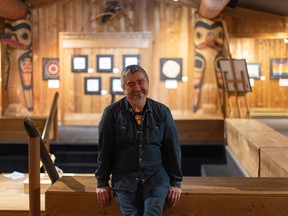
Article content
Reviews and recommendations are unbiased and products are independently selected. Postmedia may earn an affiliate commission from purchases made through links on this page.
This year is the 50th anniversary of Roy Henry Vickers’ career as an artist.
The marker is shared with another major milestone: his 79th birthday, which the renowned Tsimshian artist celebrated in early June.
Despite these commemorations, the Order of Canada and Order of B.C. recipient isn’t spending much time reflecting on his legacy.
“I don’t go there,” said Vickers. “It continues to be an inspirational ride, and inspiration is divine. I am in my 80th year, it’s like, I don’t have a lot of time left, so I’ve got to get busier as an artist.”
To help with that productivity, Vickers says, he just set up “a studio of my dreams.”
Those who know him can confirm Vickers isn’t one to look back.
“He’s always moving on to the next project, the next thing. I don’t think he spends too much time stewing on that kind of thing,” said author Lucky Budd, who has collaborated with Vickers on 15 books.
Daniela Petosa, director at the Roy Vickers Gallery in Tofino, agrees.
“He doesn’t seem to second guess,” said Petosa, herself an accomplished artist. “I think that’s why he’s been so prolific in his life … when he’s ready to put out a work, he releases it. And then he doesn’t look back, which is really cool.”
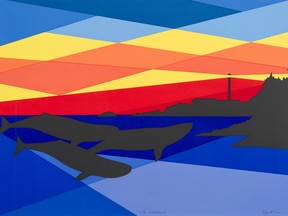
With his clean lines and vivid colours, Vickers merges traditional Indigenous art with a contemporary style to create works inspired by the B.C. landscape.
Vickers’s paintings, prints and carvings can be found in private and public collections and galleries worldwide, including the Canadian Museum of Civilization in Ottawa, the McMichael Canadian Art Collection in Kleinburg, Ont., and the National Museum of Ethnology in Osaka, Japan.
Closer to home, Vickers’s work is in UBC’s Museum of Anthropology, the home for his first solo show in 1977, titled Beginnings: Roy Vickers’ Works. That show was also the MOA’s first solo show of a contemporary Northwest Coast artist.
“Roy Henry Vickers has demonstrated how an artist can realize a career that spans ceremonial and commercial creation for both community effect and public appreciation,” said Jennifer Kramer, curator, Pacific Northwest, for UBC’s MOA.
Anyone who has visited Tofino will likely have spent time in the Roy Vickers Gallery. The stunning traditional Northwest Coast longhouse, with its carved and painted cedar exterior, is a Tofino landmark.
“People have tears in their eyes. There’s a feeling in this place. It is such a unique building,” said Petosa.
Built 40 years ago by Vickers and family members, along with master carver Henry Nolla, the gallery at 350 Campbell St., is for sale for just under $4 million.
“I’m a long way from Tofino, so it’s time to just let it go and move on with life and do more artwork for the rest of my life. And I’m very excited about it,” said Vickers, an early leader in the contemporary Indigenous art world.
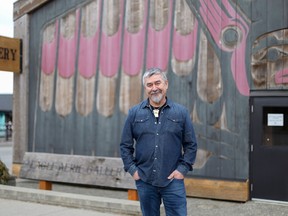
Well known primarily as a visual artist, printmaker and carver, Vickers is also a sought-after speaker who continues the rich storytelling heritage of the Northwest Coastal people as well as speaking on trauma, substance abuse and recovery.
“That’s about healing,” said Vickers, who began his own recovery in 1992. “For me, it’s three generations of trauma. When you look at a lot of my postings on social media, there are three orange hearts, and that signifies three generations from the first residential school person to me … there still is no healing. And so the pain and the trauma continues. And the best thing we can do is realize what it’s all about and then help people heal.”
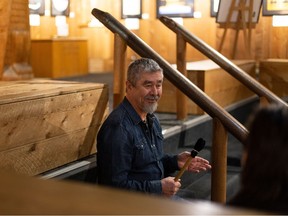
Vickers has also turned his creativity to books, with titles including The Storyteller (2014), Voices from the Skeena: An Illustrated History (2019) and Ben the Sea Lion (2022). He is the illustrator and co-author of the popular children’s First West Coast Book series and Northwest Coast Legends series. He also recently created Inspired: A Roy Henry Vickers Colouring Book.
Vickers was reached for this story at his longtime home in Hazelton.
“I’m beside the Skeena River, watching the water go by and enjoying swallows flying and playing,” said Vickers, who is the father of six children ranging in age from 57 to 21.
Vickers was born in Laxgalts’ap (formerly known as Greenville) but raised in Kitkatla, Hazelton, and Victoria. Kitkatla, also known as Lax Klan and located on Dolphin Island, approximately 60 kilometres south of Prince Rupert, has been inhabited for over 5,000 years.
“I was born (in 1946) on the banks of the Nass River where mom was teaching school,” said Vickers. “She was upset because she couldn’t get to the hospital in Prince Rupert because the tide was out, and the boats were all dried up on the beach, and so she had the head of the midwives whitewash the school (to make it clean), and that’s where I was born.”
Vickers’s father, Arthur Vickers, was a fisherman who was matrilineally Tsimshian with Haida and Heiltsuk ancestry. His mom Grace Freeman was a school teacher of Yorkshire ancestry. Vickers also reports French and German lineage.
“After I was born, my dad was just taking care of mom and helping her rest. And he started laughing,” said Vickers. “Mom said, well, what is it, Art? And he said, look at the box. They had me in a cardboard box that was my cradle, and on the side of the box was printed Heinz 57.”
With all those influences to choose from, Vickers says he leaned most toward his paternal grandfather.
“My grandfather, Henry Vickers, he never went to school. He escaped residential school. His mom hid him. He grew up in the old ways, and storytelling was our education, and that’s what he taught me. So much of what guides me today comes from Henry Vickers,” he says.
After working for the Saanich Fire Department for seven years, Vickers turned his focus to art and spent two years studying traditional First Nations art and design at the Gitanmaax School of Northwest Coast Indian Art in the historical village of Ksan at Hazelton. There, he learned and honed a style that fuses contemporary with traditional forms.
Vickers left the school in 1974 and began to sell his art. But he soured on the commercial art world and decided to step away.
“By 1979, I was really uncomfortable with the commerciality of my art and of traditional Indian art, and I quit. And I bought my uncle’s fishing boat, and I went back to Kitkatla,” said Vickers. “I spent two years on the ocean, and I wound up in Tofino. And I just I realized I had to get back to my art. And so I did.”
His return was marked by a shift in his approach.
“The first years of my art, all of my studying was traditional Northwest Coast Indian art. Colours are black and red, and the form lines are very important,” said Vickers. “When I came back to Tofino, what struck me was, well, I’m not living in those ancient times. I’m living today, and I want to find a way to move my art into a different style. I just did whatever I felt like doing, and gradually colour came into it. And I was afraid of colour, because I’m partly colour blind to all colours.”
It was during this time that he visited a former art teacher, Oak Bay High School’s Bill West, who noted the colour blindness made sense when you looked at Vickers’ attraction to such bold hues.
“The other thing Mr. West said was, if you come to understand who you are and where you come from, then you create from that place. There is nobody like us in the world. Each one of us is an individual,” said Vickers. “If you can create from that place, you will be creating work that no one else can do, because they’re not you.”
And Vickers has.
His landscapes have, over the years, offered people a way to describe dramatic sunrises and sunsets.
“It was like Roy Vickers’ painting. I’ve heard that thousands of times,” said Vickers, who sold his first paintings when he was 27.
While Vickers — who sat on the board of directors as the artistic adviser for the Vancouver International Airport’s new terminal, where his large carved panel King Salmon Housefront can be seen — was able to sell pieces to Victoria galleries, his career really began to blossom when he opened the Tofino gallery and saw one of his paintings land in the spotlight.
In 1987, Vickers’s painting titled Meeting of the Chiefs was presented to Queen Elizabeth at the Commonwealth summit in Vancouver. Others at the summit received limited edition prints of the painting.
“That was massive, and it really made people stop and pay attention to young artists,” said Vickers. “It changed my career completely.”
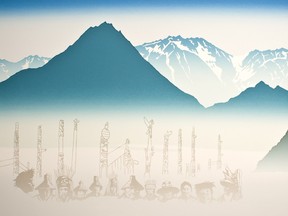
In 2018, Vickers received a Grammy nomination for his design work on the box set of CD recordings by The Grateful Dead called Pacific Northwest ’73–’74: The Complete Recordings. Last year, Vickers was appointed the inaugural Elder in Residence for the B.C. Arts Council.
“I don’t pigeonhole myself,” said Vickers when asked about how he sees himself. “When I say I’m an artist, and they say what kind of artwork do you do? I say, I do Roy Henry Vickers artwork. When they say what’s your style? I don’t know my style. You’ll have to look at it or ask somebody else what it is. Because my style is my style, and that’s it.”
Whatever his style, it transfers across his various projects, from carving and painting, to graphic design and children’s books. Vickers is moving forward with a book about Northwest Coast food and he is working with the village of Kitkatla as a master carver — a title he notes he’s “not comfortable with at all” — on its big house.
Next summer, Summer Brings Berries, the 15th book in the children’s book series First West Coast Book, will be released. The long-running book project began after author Lucky Budd saw Vickers speak and convinced him that his oral stories would work well as books for young children.
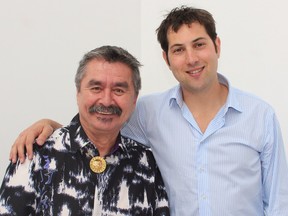
With a successful partnership and even more successful friendship between them, Budd has thoughts on what Vickers’ legacy.
“It’s a humongous question,” said Budd. “He has done a tremendous amount of work in teaching the world about the people, places, animals and beauty of the people and places of the Northwest Coast. He’s a teacher.”











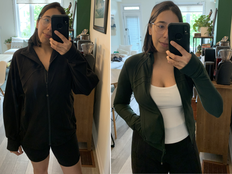





Postmedia is committed to maintaining a lively but civil forum for discussion. Please keep comments relevant and respectful. Comments may take up to an hour to appear on the site. You will receive an email if there is a reply to your comment, an update to a thread you follow or if a user you follow comments. Visit our Community Guidelines for more information.